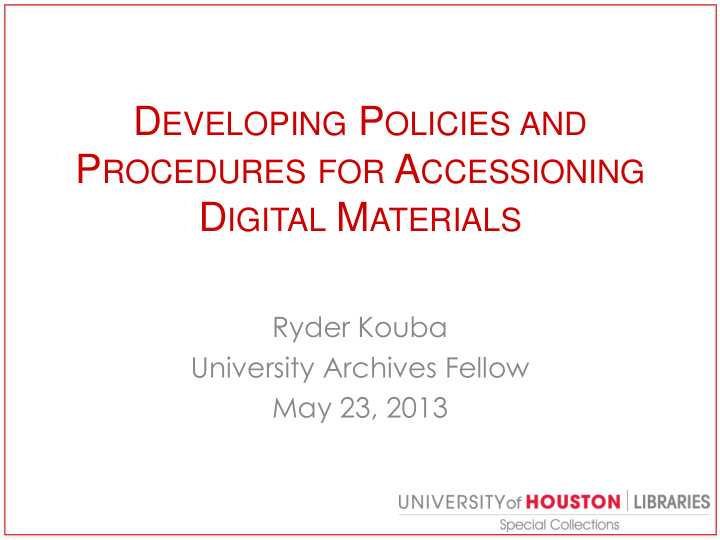



D EVELOPING P OLICIES AND P ROCEDURES FOR A CCESSIONING D IGITAL M ATERIALS Ryder Kouba University Archives Fellow May 23, 2013
O VERVIEW • Case study for University of Houston Archives – Development of accessioning procedures and policies for digital materials – Discussion of tools used and storage structure • Duke Data Accessioner • Archival Information Package
D IGITAL A CCESSIONING B ASICS • Similar to traditional materials with some unique challenges – Obsolete or inaccessible media – Transferring materials safely – Maintaining authenticity • Metadata is crucial
I N THE BEGINNING . . . • Digital materials largely undocumented • No short-term migration procedures • No long-term management policies • Increase in number of contemporary accessions
T ECHNICAL L IMITATIONS • What can we accession immediately? – CDs (data and audio) and DVDs • Purchased write-blocker for USB devices and hard drives • Not currently equipped for – Floppy disks, assorted other media formats
G OALS • Short-term – Safely copy materials from removable media to server for preservation • Long-term – Create extensible policies and procedures for managing digital materials
F IRST S TEPS • Survey collections for digital media • Create digital accession log to document incoming digital media – Received ~600 CDs in first two months • Set up pilot program and initial policies
A RCHIVAL I NFORMATION P ACKAGE (AIP) • Based on OAIS Reference Model • Contains: – Technical and descriptive metadata – Content
I MAGING VS . C OPYING • Imaging – Bit-by-bit copy of everything on disk • Includes deleted files and unallocated space – Creates single file; cannot alter files inside • Copying – Transfer selected files using specialized software – Requires less space, but more fragile
D UKE D ATA A CCESSIONER • Safely copies selected files • Generates basic technical metadata – MD5 checksums, file name, size, last modified date
S TORAGE • Files are currently on backed up server with RAID system – Looking into additional backup, including cloud storage • Working with others on procedures for depositing materials in dark archive
C URRENT W ORKFLOW • Acquire and log materials • Create AIP structure for accession • Copy files into AIP and generate metadata
N EXT S TEPS • Processing copied files – Arranging, describing, and stabilizing • Access – Short-term: Stripped-down reading room computer – Long-term: DAMS • Students take over copying files • Increase manageable media formats
R EFERENCES • General papers – AIMS Born-Digital Collections: An Inter-Institutional Model for Stewardship – Erway – “You’ve Got to Walk Before You Can Run” – Daines – “Processing Digital Records and Manuscripts” • Various institutions’ workflows – Michigan, Michigan State, Stanford
C ONTACT I NFORMATION Ryder Kouba University Archives Fellow University of Houston Special Collections rkouba@uh.edu
Recommend
More recommend